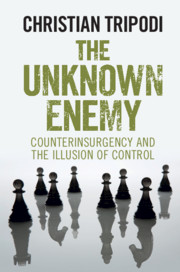Refine search
Actions for selected content:
15401 results in Military history
6 - Pacification in Vietnam 1964–72
-
- Book:
- The Unknown Enemy
- Published online:
- 06 November 2020
- Print publication:
- 12 November 2020, pp 112-137
-
- Chapter
- Export citation
Preface
-
- Book:
- The Unknown Enemy
- Published online:
- 06 November 2020
- Print publication:
- 12 November 2020, pp ix-xiii
-
- Chapter
- Export citation
2 - Themes and Issues
-
- Book:
- The Unknown Enemy
- Published online:
- 06 November 2020
- Print publication:
- 12 November 2020, pp 24-45
-
- Chapter
- Export citation
Notes
-
- Book:
- The Unknown Enemy
- Published online:
- 06 November 2020
- Print publication:
- 12 November 2020, pp 227-271
-
- Chapter
- Export citation
9 - Conclusion
-
- Book:
- The Unknown Enemy
- Published online:
- 06 November 2020
- Print publication:
- 12 November 2020, pp 196-208
-
- Chapter
- Export citation
Index
-
- Book:
- The Unknown Enemy
- Published online:
- 06 November 2020
- Print publication:
- 12 November 2020, pp 272-282
-
- Chapter
- Export citation
Bibliography
-
- Book:
- The Unknown Enemy
- Published online:
- 06 November 2020
- Print publication:
- 12 November 2020, pp 209-226
-
- Chapter
- Export citation
Acknowledgements
-
- Book:
- The Unknown Enemy
- Published online:
- 06 November 2020
- Print publication:
- 12 November 2020, pp xiv-xvi
-
- Chapter
- Export citation
5 - ‘Hearts and Minds’ vs French Revolutionary War: Algeria 1954–62
-
- Book:
- The Unknown Enemy
- Published online:
- 06 November 2020
- Print publication:
- 12 November 2020, pp 89-111
-
- Chapter
- Export citation

The Unknown Enemy
- Counterinsurgency and the Illusion of Control
-
- Published online:
- 06 November 2020
- Print publication:
- 12 November 2020

Love between Enemies
- Western Prisoners of War and German Women in World War II
-
- Published online:
- 06 November 2020
- Print publication:
- 19 November 2020

The Cambridge History of Warfare
-
- Published online:
- 31 October 2020
- Print publication:
- 04 June 2020
-
- Textbook
- Export citation
14 - The Paris Peace Conference
-
- Book:
- World War One
- Published online:
- 08 October 2020
- Print publication:
- 29 October 2020, pp 383-408
-
- Chapter
- Export citation
10 - Upheaval and Uncertainty
-
- Book:
- World War One
- Published online:
- 08 October 2020
- Print publication:
- 29 October 2020, pp 263-284
-
- Chapter
- Export citation
Contents
-
- Book:
- World War One
- Published online:
- 08 October 2020
- Print publication:
- 29 October 2020, pp v-vi
-
- Chapter
- Export citation
Acknowledgments
-
- Book:
- World War One
- Published online:
- 08 October 2020
- Print publication:
- 29 October 2020, pp xvii-xviii
-
- Chapter
- Export citation
Boxes
-
- Book:
- World War One
- Published online:
- 08 October 2020
- Print publication:
- 29 October 2020, pp xi-xii
-
- Chapter
- Export citation
Figures and Tables
-
- Book:
- Military Politics of the Contemporary Arab World
- Published online:
- 16 October 2020
- Print publication:
- 29 October 2020, pp vi-vi
-
- Chapter
- Export citation
Acknowledgments
-
- Book:
- Military Politics of the Contemporary Arab World
- Published online:
- 16 October 2020
- Print publication:
- 29 October 2020, pp vii-viii
-
- Chapter
- Export citation
Index
-
- Book:
- Military Politics of the Contemporary Arab World
- Published online:
- 16 October 2020
- Print publication:
- 29 October 2020, pp 295-298
-
- Chapter
- Export citation
